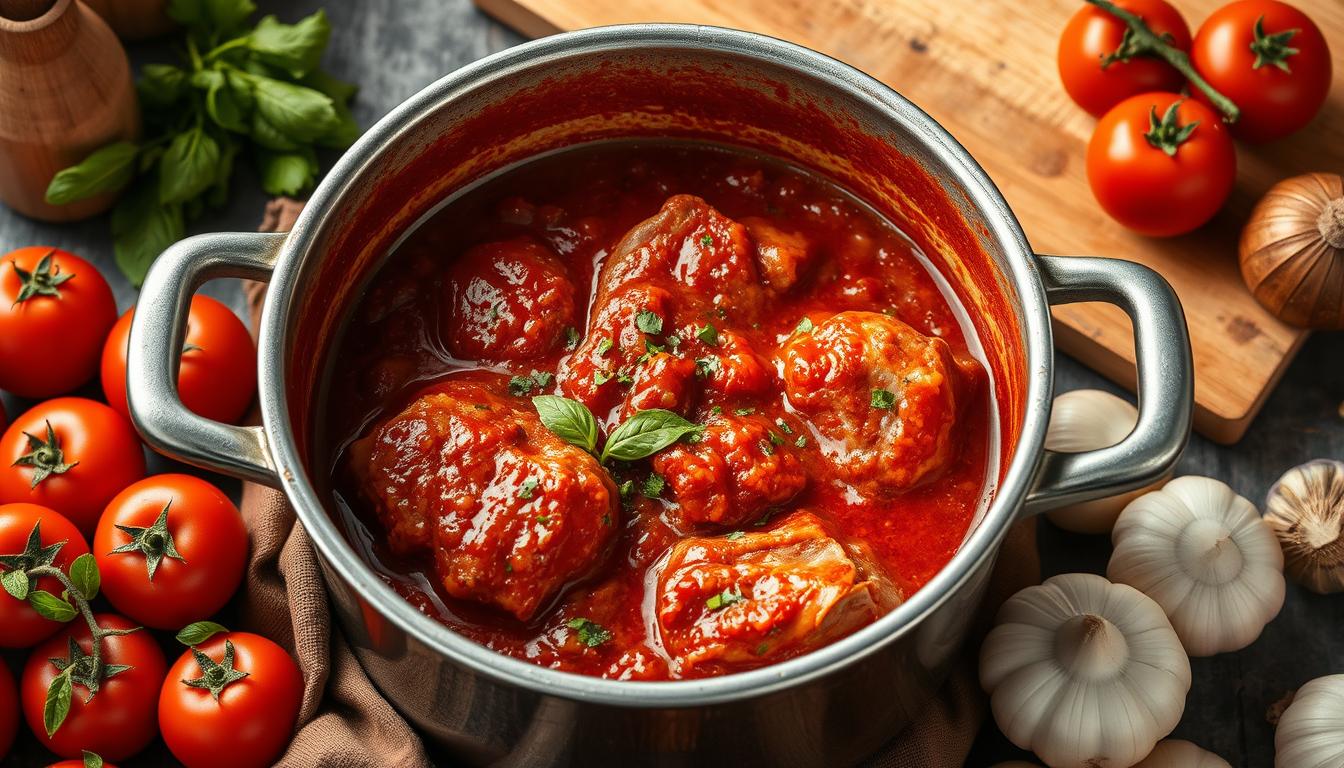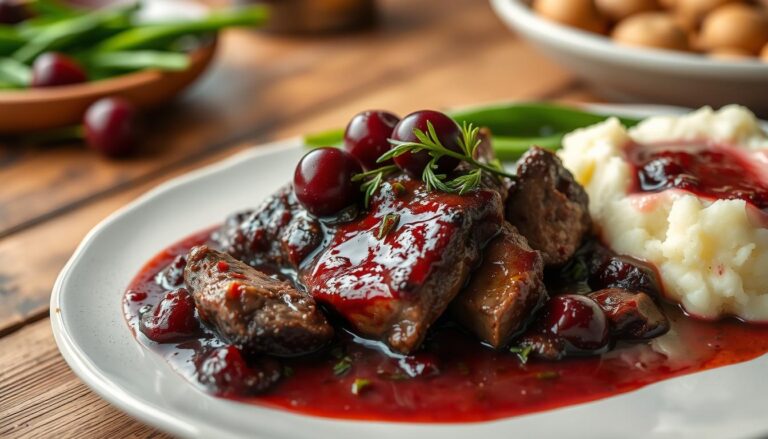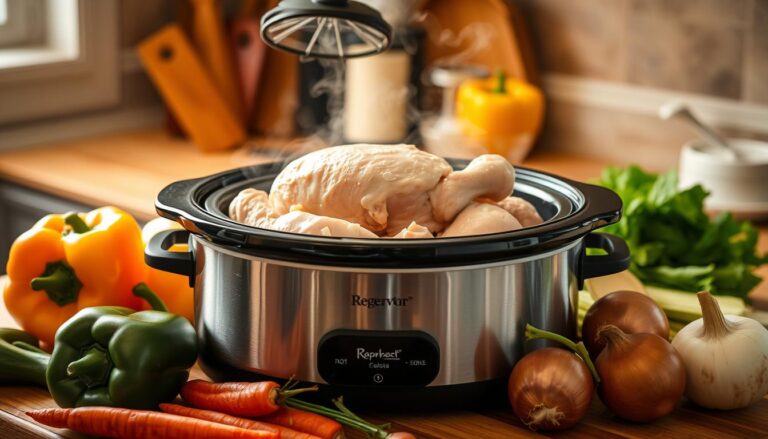Cook Tough Cuts in Tomato Sauce Recipe – Easy Guide
As a busy parent, I face the challenge of a tight budget and wanting to feed my family well. I’m excited to share a simple way to make tough, cheap cuts of meat tender and tasty with tomato sauce. With a few tricks and the right ingredients, you can make chuck roast, brisket, and short ribs into a delicious meal. It’s both affordable and satisfying.
Key Takeaways
- Discover how to tenderize tough meat cuts through slow cooking in a rich tomato sauce
- Learn the best cuts of beef for braising in tomato sauce, and why they become so tender
- Explore the essential ingredients and techniques for building a flavorful tomato sauce base
- Understand the role of aromatics and herbs in developing complex flavors in the sauce
- Troubleshoot common issues like watery sauce or overcooked meat for perfect results every time
Understanding Tough Cuts and Their Potential
When making tomato sauce, choosing the right meat is key. Tender cuts like filet mignon or chicken breasts might seem like the best choice. But, it’s the tougher, more affordable cuts that really shine in slow-cooked sauces.
These cuts, such as bottom round roast or beef chuck, have a lot of potential. They can become incredibly tender and flavorful with slow cooking.
Best Cuts for Slow Cooking in Sauce
Tough cuts like bottom round roast are perfect for slow cooking. The low heat and moist environment break down the meat’s connective tissues. This turns the tough meat into a tender, flavorful dish.
These cuts are often cheaper but can absorb the tomato sauce’s rich flavors. This creates a dish that is both harmonious and satisfying.
Why Tough Cuts Become Tender in Sauce
The secret to tenderizing tough cuts is collagen. Collagen is a tough connective tissue that can make meat chewy. But, when slow-cooked, it breaks down into gelatin.
This makes the meat tender and infuses it with the sauce’s flavors. It’s a magical transformation that happens with slow cooking.
Benefits of Slow-Cooking Method
Slow cooking tenderizes tough cuts and develops deep flavors. The long cooking time lets the ingredients blend together. This creates a sauce that’s rich, thick, and full of taste.
This method is also cost-effective. It turns less expensive cuts of meat into a dish that rivals restaurant quality. It’s a great choice for home cooks looking to save money.
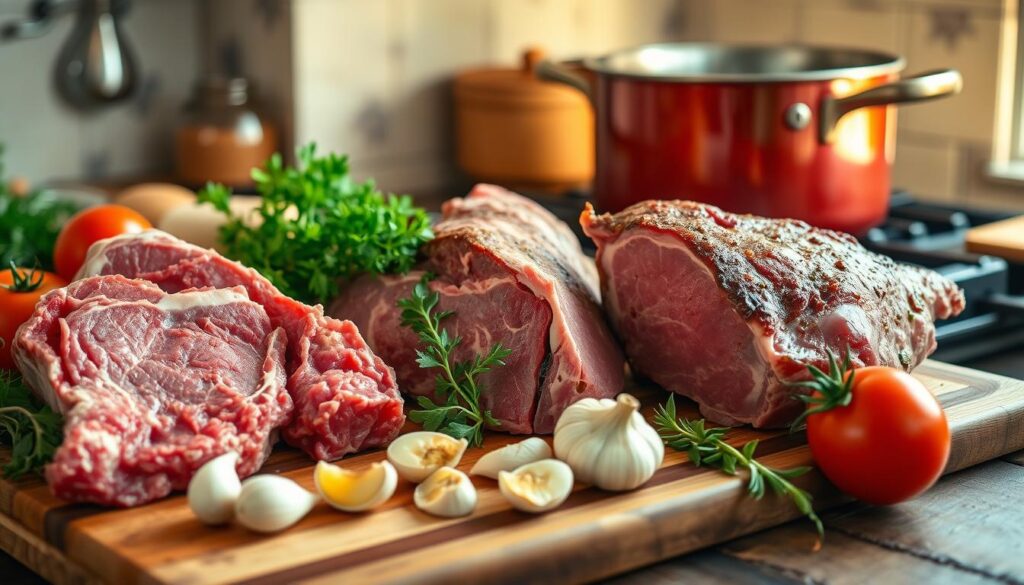
“The secret to cooking with tough cuts is to embrace the slow-cooking process. By patiently allowing the meat to break down, you’ll be rewarded with a depth of flavor that simply can’t be achieved with quick-cooking methods.”
Essential Ingredients for the Perfect Tomato Sauce Base
Making a real, italian tomato sauce from fresh tomatoes starts with the right ingredients. For a tomato sauce recipe for pasta that’s rich and flavorful, you need a few key things.
Quality tomatoes are the base of any great tomato sauce. Choose canned, San Marzano tomatoes for their sweet and slightly acidic taste. These tomatoes are known for being the best for sauce. You can adjust the sauce’s texture by chopping the tomatoes.
Next, mix olive oil and butter for a creamy sauce. Add onions and garlic to deepen the flavor. Fresh basil and dried oregano give it that Italian taste. A bit of sugar balances the acidity.
| Ingredient | Quantity |
|---|---|
| Canned Crushed Tomatoes (San Marzano) | 2 28-ounce cans |
| Olive Oil | 2 tablespoons |
| Onion, chopped | 1 medium-sized |
| Garlic, minced | 4 cloves |
| Dried Oregano | 1 teaspoon |
| Dried Basil | 1 teaspoon |
| Sugar | 1 teaspoon |
| Kosher Salt and Freshly Ground Black Pepper | To taste |
By picking and mixing these key ingredients, you make a tomato sauce recipe for pasta that looks good and tastes amazing.
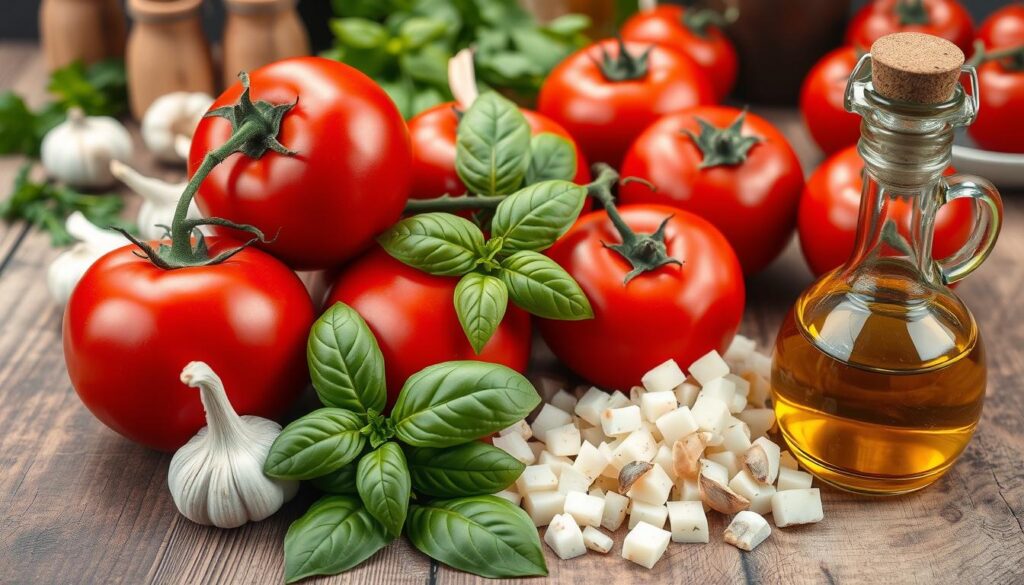
“The secret to a truly delicious Italian tomato sauce lies in the quality of the ingredients and the care taken in their preparation.”
How to Cook Tough Cuts in Tomato Sauce Recipe
Unlock the flavor of tough meat by cooking it in a rich tomato sauce. This recipe turns even the toughest cuts into tender, delicious bites. Whether you’re wondering can you cook meat in tomato sauce or how to cook tomatoes in a pan, this guide will help.
Preparation Steps
- Begin by tenderizing the meat. Use a meat mallet or the back of a heavy knife to pound it into tenderness.
- Then, coat the meat in all-purpose flour for an even layer.
- Next, sear the meat in a hot pan with olive oil and butter until it’s golden brown.
- Finally, sauté garlic and onions in the same pan to add their flavors to the fat.
Cooking Temperature Guidelines
For tender meat, cook low and slow. Keep the temperature between 200°F and 250°F. This slow cooking breaks down connective tissues, making the meat tender.
Timing and Doneness Indicators
Cook for about 1.5 hours in the oven. The meat is ready when it’s fork-tender and the sauce has thickened. Watch closely, as timing can vary based on the meat and oven.
By following these steps and guidelines, you’ll make a delicious can you cook meat in tomato sauce dish. It will impress your family and guests. Slow-cooked, tender meat in rich tomato sauce is magic.
Selecting and Preparing Fresh Tomatoes vs Canned Options
Choosing between tomato sauce from fresh tomatoes and italian tomato sauce from fresh tomatoes can change the taste and texture of your dish. Fresh tomatoes give a seasonal flavor, while canned tomatoes are consistent all year.
If you can get your hands on ripe, in-season tomatoes, they’re a great pick for your sauce. But, they need more work. You have to peel and crush them by hand. This makes the sauce cook longer, which helps the flavors blend and the sauce get smooth.
| Fresh Tomatoes | Canned Tomatoes |
|---|---|
| Require peeling and crushing | More consistent year-round |
| Need longer cooking time | Choose whole peeled plum tomatoes and crush by hand |
| Offer a seasonal and vibrant taste | Avoid diced or puréed canned tomatoes |
Canned tomatoes are easier to use. Pick whole peeled plum tomatoes and crush them yourself. This keeps the sauce thick and prevents it from getting too watery. Don’t use diced or puréed canned tomatoes, as they make the sauce too thin.
Whether you pick fresh or canned, choose the best tomatoes you can find. They’re the base of your tomato sauce. With the right tomatoes, you can make a sauce that makes your dishes stand out.
The Role of Aromatics and Herbs in Flavor Development
Creating a true italian tomato sauce from fresh tomatoes needs careful use of aromatics and herbs. These ingredients add amazing smells and depth to the sauce. They make the sauce more complex and balanced.
Essential Herbs for Italian-Style Sauce
The heart of a classic italian tomato sauce from fresh tomatoes is its herbs. Basil and oregano are key, with fresh basil adding a bright taste. Dried oregano brings an earthy, peppery flavor.
Garlic and Onion Preparation Techniques
Garlic and onions are also key for flavor in a italian tomato sauce from fresh tomatoes. Hand-chopping garlic lets it slowly add flavor as it cooks. Dicing onions by hand makes the sauce smooth.
Adding Depth with Seasonings
Other seasonings can also boost a italian tomato sauce from fresh tomatoes‘ flavor. A bit of red pepper flakes adds a nice heat. Worcestershire sauce adds a savory, umami taste.
“Sauces are considered one of the greatest tests of a chef’s skill, showcasing technical expertise, understanding of food, and the ability to evaluate flavors, textures, and colors.”
With the right mix of aromatic ingredients and seasonings, you can make a italian tomato sauce from fresh tomatoes that looks great and tastes amazing.
Secret Techniques for Rich and Thick Sauce Texture
Improving your tomato sauce’s texture can elevate your pasta dish. A few simple techniques can turn a basic sauce into a rich, velvety delight. This makes it perfect for your tonnato sauce or tomato sauce recipe for pasta.
Begin by mixing olive oil and butter. This blend gives your sauce a creamy feel that sticks to your tongue. Cooking the sauce in the oven slowly caramelizes it, adding depth without burning.
Crushing tomatoes by hand instead of blending keeps them chunky. This adds texture and substance to your dish.
Let the sauce simmer and reduce slowly. This concentrates the flavors. Stir it occasionally to blend the ingredients and reach the right consistency. Adding a bit of tomato paste or red wine vinegar can enhance the taste.
| Technique | Benefit |
|---|---|
| Blending olive oil and butter | Creates a creamy, velvety texture |
| Slow-cooking in the oven | Allows for rich caramelization without burning |
| Hand-crushing tomatoes | Achieves a perfectly chunky texture |
| Allowing sauce to reduce slowly | Concentrates flavors for a richer taste |
| Occasional stirring | Helps meld flavors and achieve desired consistency |
With these secret techniques, you’ll craft a tonnato sauce or tomato sauce recipe for pasta that looks great and tastes amazing.
Troubleshooting Common Sauce Issues
Creating a perfect tomato sauce with tender meat is a fun challenge. But, we’ve got you covered for any issues. If your sauce is too watery, the seasoning’s off, or the meat’s overcooked, we have simple fixes. These will help you achieve that rich, flavorful sauce you’re aiming for.
Fixing Watery Sauce
Don’t worry if your tomato sauce is too thin. Just simmer it uncovered over medium heat. This will let the excess moisture evaporate. Stir it now and then until it’s thick enough for you.
This gentle simmering will also concentrate the flavors. It will make your sauce velvety and luxurious.
Addressing Seasoning Problems
Getting the seasoning right in tomato sauce can take some tries. If it tastes flat or unbalanced, add seasonings slowly. Taste as you go. A bit of salt, dried herbs, or lemon juice can really help.
It’s better to add more seasoning than to fix an overseasoned sauce.
Salvaging Overcooked Meat
Oh no, your meat has cooked too long and is dry or stringy. But, there’s still hope! Shred the meat gently and mix it back into the sauce. The sauce will rehydrate the meat and add flavor.
If the sauce is too tart, a bit of sugar can balance it out.
With these tips, you’ll get better at cooking how long to cook tough cuts in tomato sauce recipe. A bit of patience and attention will help you fix any sauce problem. You’ll enjoy a delicious, hearty meal in no time.
Serving Suggestions and Pairing Options
Once you’ve made your homemade tomato sauce, you can serve it in many ways. It goes well with different dishes and sides, making it a great addition to any meal.
Try it over freshly cooked pasta for a classic taste. The sauce’s creamy texture makes the noodles feel extra special. You can also serve it over creamy polenta or mashed potatoes for a filling meal.
For a tasty way to enjoy every bit of the tomato sauce recipe for pasta, serve it with a crusty loaf of bread. The sauce’s rich flavors match the bread’s crunchy outside and soft inside perfectly.
Add a sprinkle of Parmesan cheese and some fresh basil on top. The cheese’s sharp taste and the basil’s fresh aroma will make the sauce even better.
The tomato sauce is also great as a base for other dishes. Use it as a topping for tomato sauce recipe for pasta-based meals like lasagna, baked ziti, or eggplant Parmesan. Its bold flavors will blend well with the other ingredients.
For wine, bold reds like Chianti, Zinfandel, or Sangiovese go well with the sauce’s strong flavors.
This versatile tomato sauce recipe will impress everyone. Try different ways of serving it to find your favorite flavors.
Storage and Reheating Guidelines
Storing and reheating your homemade tomato sauce with tough cuts right is key. It keeps the flavor and texture just right. Follow a few easy steps to enjoy your dish again after it’s first cooked.
Proper Storage Methods
Keep leftovers in an airtight container in the fridge for 3-4 days. For longer storage, freeze it for 2-3 months. Make sure to leave some space in the container for expansion.
Use canning jars for the best seal. They keep the sauce fresh and prevent spoilage.
Best Reheating Practices
Reheat your sauce gently on the stovetop or in the microwave. If it’s too thick, add a bit of broth or water. This keeps it smooth.
Thaw frozen sauce in the fridge overnight before reheating. The flavors get better with time, so let it rest before serving.

